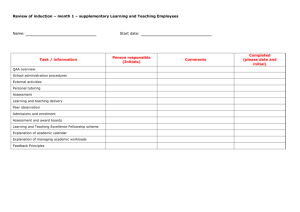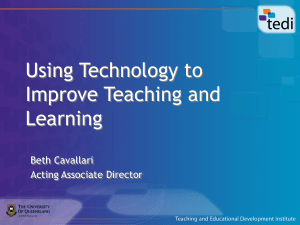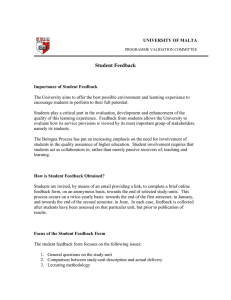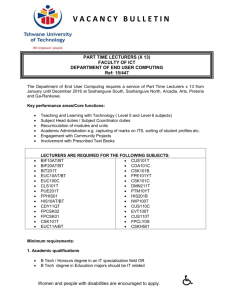Document 14092739
advertisement
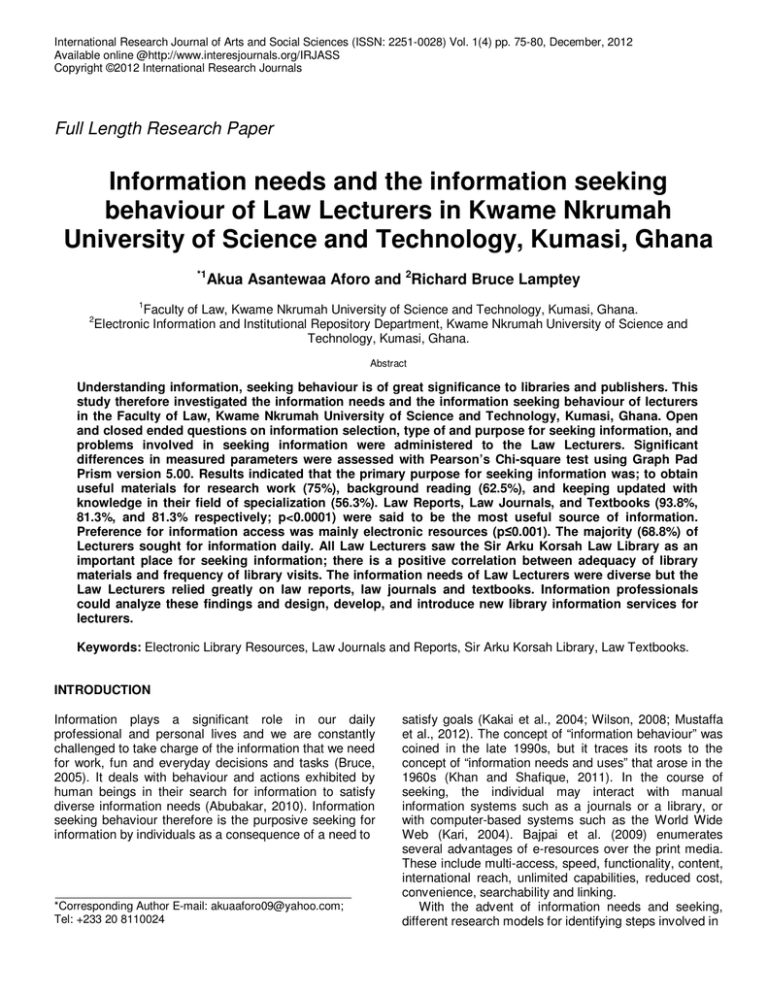
International Research Journal of Arts and Social Sciences (ISSN: 2251-0028) Vol. 1(4) pp. 75-80, December, 2012 Available online @http://www.interesjournals.org/IRJASS Copyright ©2012 International Research Journals Full Length Research Paper Information needs and the information seeking behaviour of Law Lecturers in Kwame Nkrumah University of Science and Technology, Kumasi, Ghana *1 Akua Asantewaa Aforo and 2Richard Bruce Lamptey 1 Faculty of Law, Kwame Nkrumah University of Science and Technology, Kumasi, Ghana. Electronic Information and Institutional Repository Department, Kwame Nkrumah University of Science and Technology, Kumasi, Ghana. 2 Abstract Understanding information, seeking behaviour is of great significance to libraries and publishers. This study therefore investigated the information needs and the information seeking behaviour of lecturers in the Faculty of Law, Kwame Nkrumah University of Science and Technology, Kumasi, Ghana. Open and closed ended questions on information selection, type of and purpose for seeking information, and problems involved in seeking information were administered to the Law Lecturers. Significant differences in measured parameters were assessed with Pearson’s Chi-square test using Graph Pad Prism version 5.00. Results indicated that the primary purpose for seeking information was; to obtain useful materials for research work (75%), background reading (62.5%), and keeping updated with knowledge in their field of specialization (56.3%). Law Reports, Law Journals, and Textbooks (93.8%, 81.3%, and 81.3% respectively; p<0.0001) were said to be the most useful source of information. Preference for information access was mainly electronic resources (p≤0.001). The majority (68.8%) of Lecturers sought for information daily. All Law Lecturers saw the Sir Arku Korsah Law Library as an important place for seeking information; there is a positive correlation between adequacy of library materials and frequency of library visits. The information needs of Law Lecturers were diverse but the Law Lecturers relied greatly on law reports, law journals and textbooks. Information professionals could analyze these findings and design, develop, and introduce new library information services for lecturers. Keywords: Electronic Library Resources, Law Journals and Reports, Sir Arku Korsah Library, Law Textbooks. INTRODUCTION Information plays a significant role in our daily professional and personal lives and we are constantly challenged to take charge of the information that we need for work, fun and everyday decisions and tasks (Bruce, 2005). It deals with behaviour and actions exhibited by human beings in their search for information to satisfy diverse information needs (Abubakar, 2010). Information seeking behaviour therefore is the purposive seeking for information by individuals as a consequence of a need to *Corresponding Author E-mail: akuaaforo09@yahoo.com; Tel: +233 20 8110024 satisfy goals (Kakai et al., 2004; Wilson, 2008; Mustaffa et al., 2012). The concept of “information behaviour” was coined in the late 1990s, but it traces its roots to the concept of “information needs and uses” that arose in the 1960s (Khan and Shafique, 2011). In the course of seeking, the individual may interact with manual information systems such as a journals or a library, or with computer-based systems such as the World Wide Web (Kari, 2004). Bajpai et al. (2009) enumerates several advantages of e-resources over the print media. These include multi-access, speed, functionality, content, international reach, unlimited capabilities, reduced cost, convenience, searchability and linking. With the advent of information needs and seeking, different research models for identifying steps involved in 76 Int. Res. J. Arts Soc. Sci. this process have been proposed e.g. the standard model, the cognitive model, the dynamic model, search as a sequence of stages, search as a strategic process, and sense making (Hearst, 2009). Jarvelin and Wilson (2003) discussed the functions of conceptual models in scientific research in Information science and research and concluded that some models are of summary type and others more analytic. Such models serve different research purposes. The summary type involved Starting: the means employed by the user to begin seeking information, for example, asking some knowledgeable colleague; Chaining: following footnotes and citations in known material or 'forward' chaining from known items through citation indexes; Browsing: 'semi-directed or semistructured searching'; Differentiating: using known differences in information sources as a way of filtering the amount of information obtained; Monitoring: keeping upto-date or current awareness searching; Extracting: selectively identifying relevant material in an information source; Verifying: checking the accuracy of information; and Ending: which may be defined as 'tying up loose ends' through a final search. Seeking information by the analytics method involved the following classifications; task complexity, task categorization, and types of information needed in tasks (Jarvelin and Wilson, 2003). Shokeen and Kushik (2002) studied information seeking behaviour of social scientists working in the universities located in Haryana. They reported most of the social scientists visit the library daily. The first preferred method of searching the required information by the social scientists followed by searching through indexing and abstracting periodicals, and citations in articles respectively. The social scientists use current journals followed by books. Cothey (2002) examined the information seeking behaviour of 206 college students using the World Wide Web during a 10-month period as a means to suggesting how the general population uses the web. It was concluded that World Wide Web users have become more passive and more eclectic as they become more experienced using the Web. It was also discovered that they use less querying techniques; however their Web usage was more sporadic, which might suggest greater selectivity. Information seeking behaviour of scholars has been the focus of inquiry within the library and information science community for decades (Meho and Tibbo, 2003). Understanding the information-seeking behaviour of educators has great significance not only to libraries, which spend considerable funds purchasing and finding tools for literature search, but also to publishers, who invest in technology to make their electronic journals available. Research into information seeking behaviours had been previously undertaken for reasons of improving collection development. Information seekers encounter various challenges. A study by Tahir et al. (2008) identified seventeen possible problems teachers face in acquiring information for teaching and research. Respondents were asked to rank these problems using a five-point Likert scale. “Required material is not available” was ranked as the number one problem with a mean of 3.17, followed by “information is scattered in too many sources” and “information sources are very expensive” with mean scores of 3.60 and 3.47 respectively. Other challenges on the list were information sources located far away, lack of time, lack of training in information literacy skills, lack of knowledge in using the library, language barrier and incompetent or not well trained library staff. Faculties in educational institutions contribute to the attainment of the broad objectives of the university which is teaching, research, and community service. The faculties provide academic guidance to students and extend the frontiers of knowledge through research and publication. This makes faculty members' need for information inevitable. Information seeking behaviour of Faculty members is paramount to libraries because libraries have a role to play in helping members meet their information needs. This study, therefore, sought to investigate information systems such as journals or a library, or of the KNUST Faculty of Law Lecturers, by determining the kind of information they use, members, their purpose of information seeking; the problems faced while seeking and using information and to make recommendations to improve their information seeking behaviour and the entire lecturing body of the University on the whole. MATERIALS AND METHODS Study Population Lecturers in the Faculty of Law, KNUST, Ghana, were used in this study. This Faculty belongs to the College of Art and Social Sciences, one on the six prominent Colleges of the University. The Law Faculty promotes the development of the Ghanaian body of law through teaching and research. Students who study in this Faculty go through a 4 year LL.B. programme to obtain Bachelor of Laws (LL.B.) degree. The Faculty has the Sir Arku Korsah Law Library to stress the importance of library and information services to law research, teaching, learning and knowledge dissemination. With nearly 10,000 books and documents, it is the second largest Law Faculty library in Ghana. The Library is committed to providing the best possible resources for legal research. Sampling Technique and Data Collection Between March and April 2011, questionnaires comprising predominantly closed ended questions on the information needs and information seeking behaviour were Aforo and Lamptey 77 Table 1. Course Taught by Law Lecturers in KNUST. Course Criminal law Jurisprudence Ghana Legal Systems Labour law Law of immovable property Equity and Trust Law of Tort Law of Contract International law Administrative law Energy and Natural Resource Law Corporate Governance Company Law Public International Law Environmental Law No Response Frequency 2 3 5 2 1 1 4 2 1 1 1 1 2 2 2 3 Source: Field Survey 2011 administered to 16 Lecturers of the Faculty of Law, KNUST, Ghana. Ethical Consideration Research consent forms were given to participants for completion. Researchers assisted those who needed assistance in understanding what was written. The Lecturers were alerted that participation in the study was voluntary and that they were free to withdraw from participation at any stage. Data Analysis All data obtained was analyzed using the Statistical Packages for Social Sciences (SPSS) version 17 (SPSS Inc., Chicago, IL, 2008). Presentation was made using frequency tables. Significant differences in measured parameters were assessed with Yates’ correction of Pearson’s Chi-square test (two-sided) using GraphPad Prism version 5.00 for Windows (San Diego California USA, www.graphpad.com). P ≤ 0.05 was considered significant. RESULTS A total of 16 Law Lecturers of which 11 (68.8%) were males and 5 (31.2%) females were sampled for use in this study. Of these, 2 (12.5%) were PhD holders and 14 (87.5%) LL.M. Although there were a number of courses in several aspects of law taught, 5 (31.2%) taught Ghana legal systems, 4 (25%) taught Law of Tort, while 3 (18.7%) taught Jurisprudence as a course. The rest of the courses were taught either by 2 lecturers or solely by one lecturer (Table 1). The primary purpose for seeking information by these Lecturers was to obtain materials that might be useful for their research work (75%), to obtain materials for background reading (62.5%), and to keep up with new knowledge in their field of specialization (56.3%). Only 12.5% saw gathering information for lectures and references for student as a primary purpose for seeking information. All the lecturers saw Law Reports as the most useful source of information, 15 (93.8%; p<0.0001) and 13 (81.3%; p<0.0001) also saw Law Journals and Textbooks respectively, as very important sources of information (Table 2). These information sources were deemed important because they provided information that was current and relevant to their needs and were easily available and accessible (Table 3). Eleven (68.8%) lecturers search for information daily, 3 (18.8%) weekly, and 3 (18.8%) monthly from Libraries (81.3%) and online databases (87.5%) from libraries. Preference for information access for Lecturers was mainly electronic resources (Table 4). The Sir Arku Korsah Law Library was seen as a very important place for all the Law Lecturers in seeking information with 14 (87.5%) visiting the library at least once a week. Fourteen (87.5%) sought for information by asking library staff and using Reports, Textbooks and Journals and from internet/online resources 12 (75.0%) rather than from colleagues (31.3%). While 13 (81.3%) 78 Int. Res. J. Arts Soc. Sci. Table 2. Important information sources mentioned by lecturers. Information Source Law Journals Textbooks Law Reports Conference proceedings Law Databases Newspapers Frequency 15 *** 13 *** 16 *** 3 ns 2 ns 1 P value Chi-square, df <0.0001 24.5, 1 <0.0001 18.29, 1 <0.0001 22.16, 1 0.285 1,143, 1 0.5442 0.3678, 1 Significant differences in the use of other sources of information compared to newspapers (the least patronized source of information) were established using Pearson’s Chi-square test (two-sided) with Yates’ correction. ns implies P > 0.05; *** implies P ≤ 0.0001. Source: Field Survey 2011 Table 3. Reasons for preference of information sources. Reason for Preference of information Source Easily available Easily accessible Format applicable to my needs Provides current information relevant to my needs Provide current information Frequency 11 11 6 13 12 Source: Field Survey 2011 Table 4. Information access point preferred by Law Lecturers. Preference for information Frequency P value Chi-square, df access for Lecturers Electronic resources 9 ** 0.0023 9.309, 1 Printed resources 6* 0.0325 4.571, 1 Electronic and Printed resources 1 Significant differences in the preference for electronic or printed information access for some Lecturers compared to those who do not mind which resource it is was established using Pearson’s Chi-square test (two-sided) with Yates’ correction. * implies P ≤ 0.05; ** implies P ≤ 0.001. Source: Field Survey 2011 do not encounter any problem seeking information from resources available in library, only 3 (18.8%) reported otherwise. On preference for information accessed, 9(56.2%; p≤0.001) wanted electronic resources, 6(37.5%; p≤0.05) wanted printed materials and 1(6.2%) wanted both. Concerning adequacy of resources only one lecturer thought it was adequate while the remaining 15 (93.8%) thought it could be further improved. All Law Lecturers wanted an update of all information seeking resources in the Sir Arku Korsah Library and (81.3%) would find it useful to receive soft copies of information on updates or of new holdings or subscription in their subject area, links to the original source held by the library in their subject area, and current Journal issues reports via email. DISCUSSION The primary purpose for seeking information is to find relevant information in relation to the fulfillment of a specific goal or information need. This study was an effort to fill a gap in understanding the information needs and information seeking behavior of Law Lectures. The lecturers sought information for their research work which enhances teaching and learning (their specific need). This is in line with what Wilson (2000) asserts 'information seeking behaviour is the purposive seeking for information as a consequence of a need to satisfy some goal'. It was evident from the study that all the lecturers consulted law reports because these are series of books Aforo and Lamptey 79 that contain judicial opinions from a selection of case law decided by courts. Law reports are core in the teaching and learning of law. The reports form the basis for explaining concepts and theories hence their use cut across all law courses. They are extremely important to law lecturers as they enable decisions to be accessed by future courts. The law reports were ranked as the most important source of information for their research and publication. It appeared that law lecturers needed the same type of information sources for research and publication. This study showed Law Reports are the most useful source of information to the lecturers for both their teaching and research work and to effectively use that information to solve issues or problems at hand as Lawyers. Significant decisions of the courts, not necessarily cases which receive a lot of media attention, but ones that will assist in the interpretation of the law in similar cases, are selectively and commercially published in various sets of law reports on a weekly or monthly basis. These are therefore classified as primary sources of information (UNISA, 2012). Secondary sources of information are works that emanate from primary sources of information but provide commentary on those sources. These include reference works such as dictionaries and encyclopaedias, books, theses and dissertations, journal articles, loose-leaf publications, indexes and abstracts (UNISA, 2012). Newspapers were the least patronized sources of information probably because the Lecturers read them in their offices or at home, or listen to newspaper review on radio so there was no need to come to the library to read from them. Almost all the Law Lecturers (87.5%) visited the Sir Arku Korsah Law Library at least once a week which suggests that majority of the Law Lecturers were satisfied with the collections, services and facilities provided by the Sir Arku Korsah Law Library for meeting their information needs. This makes the Library a very important place for seeking information. A study in Nigeria, noted a very low frequency of library visits by petroleum scientists and engineers; where about 84 % of the respondents reported visiting the library just a few times a year. It is generally known that the success of a library in meeting the information needs of its users play an important role in their future library visits. Lecturers need various kinds of information for teaching and research for the purposes of impacting knowledge in students and self-development. To achieve this, the right information must be available for the right person at the right time in its appropriate format. Oguntuase and Falaiye (2004) showed a positive correlation between adequacy of library materials and frequency of library visits by observing that the most effective way to mobilize people into the library is through the provision of required information (Adeoye and Popoola, 2011). The library is the first port of call for every academician. The library contributes to the lecturers developing their information literacy, and act as a support in the teaching process. For those that have strong desire for reading and collecting literature, a library can be a magical place of the imagination. Most of the lecturers (56.2%) preferred electronic resources to printed material. This affirms the advantages electronic resources (e.g. quick, easy, and multiple access links etc) have over manual sources (Bajpai et al., 2009). Each lecturer has a computer or access to a computer and internet, either at home or in the office so getting updates of electronic information resources is relatively easy. It was however indicated by some lecturers that the library’s facility (e.g. Law Reports, Law database, electronic journals and printed resources) could be further improved. CONCLUSION AND RECOMMENDATIONS The information needs of Law Lecturers are diverse but they rely heavily on law reports, law journals and textbooks. The Sir Arku Korsah Law Library must therefore provide adequate equipment and technology to offer effective and efficient services. Information professionals especially in Ghana, can analyze the findings of the study, design, develop, and introduce new library and information services for lecturers, and different user groups. REFERENCES Abubakar AB (2010). A Snapshot of Information-Seeking Behavior Literature in Health Sciences: a Bibliometric Approach. Library Philosophy and Practice 2010. Adeoye MO, Popoola SO (2011). Teaching Effectiveness, Availability, Accessibility, and Use of Library and Information Resources Among Teaching Staff of Schools of Nursing in Osun and Oyo State, Nigeria. Library Philosophy and Practice 2011. Available at: http://unllib.unl.edu/LPP/. Accessed on: November 9, 2012. Bajpai RP, Mal Bidjut K, Bajpai G (2009). Use of e-resources through consortia: A Boon to Users of Indian University Libraries. (CAL 2009) Library Services. Accessed on 15/11/2012 from http://crl.du.ac.in/ical09/papers/index_files/ical-85_83_195_2_RV.pdf Bruce H (2005). Personal, anticipated information need. Inform. Res. 10: (3). Cothey V (2002). A longitudinal study of World Wide Web users' information-searching behavior. Journal of the American Society for Information Science and Technology, 53(2):67. Hearst MA (2009). Search User Interfaces. Cambridge University Press, UK. Jarvelin K, Wilson TD (2003). One conceptual model for information seeking and retrieval research. Inform. Res., 9(1):163. Kakai M, Ikoja–Odongo R, Kigongo–Bukenya IMN (2004). A study of the information seeking behavior of undergraduate students of Makerere University, Uganda World Libraries, 14(1). Available at http://www.worlib.org/vol14no1/kakai_v14n1.shtml. Accessed on: November 9, 2012. Kari J (2004). "Web information seeking by pages: an observational study of moving and stopping" Information Research, 9(4) paper 183 [Available at http://InformationR.net/ir/9-4/paper183.html]. Accessed on November 10, 2012. Khan SA, Shafique F (2011). "Information Needs and InformationSeeking Behavior: A Survey of College Faculty at Bahawalpur". Library Philosophy and Practice. Paper 484. Available at: 80 Int. Res. J. Arts Soc. Sci. http://digitalcommons.unl.edu/libphilprac/484. Accessed on: November 9, 2012. Meho LI, Tibbo HR (2003). Modeling the information-seeking behaviour of social scientists. J. Am. Soc. Inform. Sci., 54(6):570-587. Mustaffa CS, Ahmad NA, Baqi SSA (2012). Assessing information seeking behavior among members of university community in malaysia and nigeria: A multigroup invariance analysis. International Conference on Communication, Media, Technology and Design (ICCMTD) Istanbul – Turkey: 59-67. Oguntuase FZ, Falaiye ZM (2004). Meeting information needs of rural communities through repackaging of information. Niger. Librar. Inform. Sci. Rev. 22(1):1-12. Shokeen A, Kushik SK (2002). Information seeking behavior of social scientists of Haryana Universities. Library Herald, 40(1):8-11. Tahir M, Mahmood K, Shafique F, (2008). Information Needs and Seeking Behavior of Arts and Humanities Teachers. Library Philosophy and Practices.Retrieved December 2011, from: http://digitalcommons.unl.edu/libphilprac/227 UNISA Library (2012). Finding legal information. Available at: http://www.unisa.ac.za/Default.asp?Cmd=ViewContent&ContentID=2 6952. Accessed on: November 9, 2012. Wilson TD (2000). Human information behavior. Special Issues on Inform. Sci. Res., 3(2):49-55. Wilson TD (2008). Human information behavior. Available: http://inform.nu/Articles/vol.3/v3n2. Accessed on November 9, 2012.
